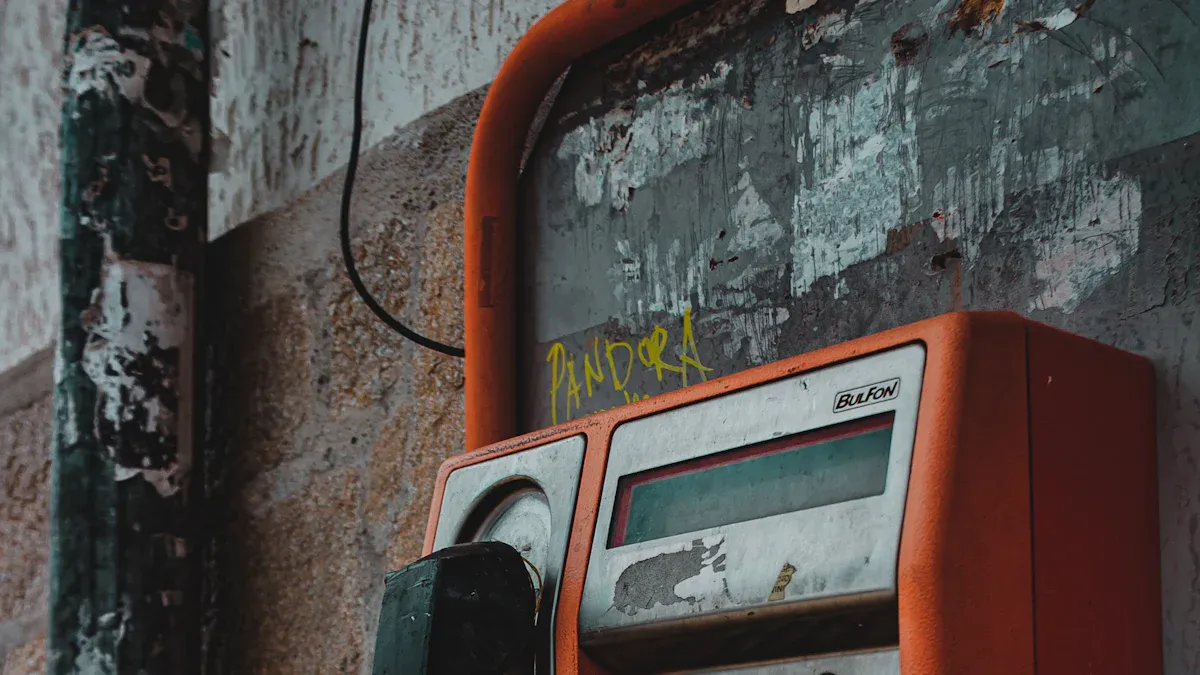
Public outdoor telephones play a key role in keeping people safe. They offer a lifeline during emergencies, especially in areas where cell service is spotty. A waterproof outdoor telephone ensures functionality in harsh weather. An industrial heavy duty telephone can withstand frequent use. For highways, a traffic emergency telephone can save lives. These phones deserve care and attention to remain reliable.
Common Issues with Public Outdoor Telephones
Vandalism and misuse
Public outdoor telephones often face vandalism. People sometimes damage them intentionally or misuse them for pranks. Broken receivers, scratched screens, and graffiti are common signs of vandalism. Misuse can also include making unnecessary calls that tie up the line. These actions reduce the reliability of the phones and make them less useful for emergencies.
Tip: Communities can help by reporting vandalism and encouraging responsible use of public resources.
Weather-related damage
Outdoor telephones are exposed to the elements year-round. Heavy rain, snow, and extreme heat can wear down their components. Moisture can seep into the wiring, causing malfunctions. In colder climates, freezing temperatures may crack plastic parts or make buttons harder to press. Without proper weatherproofing, these phones can quickly become unusable.
Technical malfunctions
Technical issues are another common problem. Over time, wear and tear can affect the internal systems of public outdoor telephones. Faulty wiring, outdated software, or damaged circuits can lead to poor sound quality or complete failure. Regular maintenance is key to catching these problems early and keeping the phones operational.
Preventative Maintenance for Public Outdoor Telephones

Routine inspections and servicing
Regular inspections are the backbone of maintaining any public outdoor telephone. Technicians should check for visible damage, such as cracks, loose parts, or missing components. They should also test the phone’s functionality by making a call to ensure clear audio and proper connectivity.
A simple checklist can make inspections more efficient:
- Inspect the handset and cord for wear and tear.
- Test the keypad to ensure all buttons work.
- Check the enclosure for signs of rust or damage.
Tip: Schedule inspections at least once a month to catch issues early. This proactive approach can prevent small problems from turning into costly repairs.
Cleaning and sanitizing regularly
Public outdoor telephones are high-touch devices. Over time, dirt, grime, and germs can accumulate on the handset and keypad. Regular cleaning not only keeps the phones hygienic but also extends their lifespan.
Use a soft cloth and a mild cleaning solution to wipe down the surfaces. Avoid harsh chemicals that might damage the materials. For sanitizing, alcohol-based wipes are a great choice.
- Focus on high-contact areas like the receiver and buttons.
- Clean the phone’s enclosure to remove dust and debris.
- Dispose of cleaning materials responsibly to avoid littering.
Keeping the phones clean makes them more inviting to use. It also shows the community that these resources are cared for and valued.
Addressing minor issues promptly
Small problems can quickly escalate if left unchecked. A loose wire or a sticky button might seem minor, but they can lead to bigger malfunctions over time. Addressing these issues as soon as they arise ensures the public outdoor telephone remains reliable.
Technicians should carry basic repair tools during inspections. This allows them to fix minor issues on the spot. For example:
- Tighten screws or bolts to secure loose parts.
- Replace worn-out cords or damaged handsets.
- Clear debris from the keypad to restore functionality.
Note: Encourage the public to report any issues they notice. Quick reporting helps technicians respond faster and keep the phones in good working order.
Protective Measures for Public Outdoor Telephones

Weatherproofing and protective enclosures
Weatherproofing is one of the most effective ways to protect public outdoor telephones from environmental damage. These phones face constant exposure to rain, snow, and extreme temperatures, which can wear down their components over time. Protective enclosures act as a shield, keeping the phone safe from these harsh conditions.
Protective cabinets are specifically designed to handle all kinds of weather. They can endure extreme heat, freezing cold, and heavy rainfall. These enclosures provide insulation that protects the phone’s sensitive electronic parts, ensuring they stay functional for longer periods. For example, the Joiwo Highway Hands Free Backlit Waterproof Speakerphone features a cold-rolled steel spraying waterproof housing. This design completely blocks out dust and moisture, making it highly reliable for outdoor use.
By investing in weatherproofing and durable enclosures, communities can ensure that public outdoor telephones remain operational, even in challenging environments.
Anti-vandalism designs and tamper-proof features
Vandalism is a major issue for public outdoor telephones, but anti-vandalism designs can help reduce this problem. These designs focus on making the phones harder to damage or tamper with. For instance, using reinforced materials like stainless steel for the handset and cord can prevent breakage. Similarly, tamper-proof screws and locks can deter people from trying to open the phone’s casing.
Another effective feature is the use of shatterproof glass for screens. This material resists scratches and cracks, keeping the phone’s display clear and functional. Some phones also include recessed keypads, which make it harder for vandals to pry off buttons. These small design changes can make a big difference in extending the lifespan of public outdoor telephones.
Communities benefit greatly from these anti-vandalism measures. They reduce repair costs and ensure that the phones are always available for emergencies.
Security cameras and adequate lighting
Installing security cameras near public outdoor telephones is another way to protect them. Cameras act as a deterrent, discouraging vandalism and misuse. When people know they’re being watched, they’re less likely to damage the phone or use it irresponsibly.
Adequate lighting also plays a crucial role. A well-lit area makes it easier for people to use the phone at night and increases the sense of safety. Bright lighting can also make it harder for vandals to act without being noticed. Combining cameras with good lighting creates a secure environment for both the phone and its users.
These protective measures not only safeguard the phone but also encourage more people to use it when needed. A secure and well-maintained public outdoor telephone becomes a trusted resource for the community.
Community Role in Maintaining Public Outdoor Telephones
Reporting issues to authorities
Communities play a big role in keeping public outdoor telephones functional. Reporting problems to local authorities is one of the easiest ways to help. When people notice broken parts, vandalism, or technical issues, they should contact the responsible department right away. Quick reporting allows technicians to fix problems before they get worse.
Many cities provide hotlines or online forms for reporting public issues. These tools make it simple for residents to share concerns. Some areas even have apps that let users upload photos of damaged phones. This extra detail helps repair teams understand the problem better.
Tip: Encourage neighbors to report issues as soon as they spot them. A small effort can make a big difference in keeping these phones reliable.
Promoting responsible use through education
Education is key to protecting public outdoor telephones. When people understand their importance, they’re less likely to misuse them. Schools, community centers, and local events can teach residents about the value of these phones. Simple lessons on responsible use—like avoiding prank calls or damaging equipment—can go a long way.
Posters and signs near the phones can also remind users to treat them with care. Messages like “Use responsibly—this phone saves lives” can make people think twice before misusing them.
Callout: Communities that promote education often see fewer cases of vandalism and misuse.
Collaborating with local organizations
Local organizations can help maintain public outdoor telephones. Groups like neighborhood associations or nonprofits often have the resources to organize cleanups or fund repairs. They can also partner with city officials to install protective features like enclosures or security cameras.
Community events, like “Adopt-a-Telephone” programs, encourage residents to take ownership of nearby phones. These initiatives build pride and responsibility, ensuring the phones stay in good condition.
Example: A local scout troop might volunteer to clean and inspect phones as part of a service project.
By working together, communities and organizations can keep public outdoor telephones safe and functional for everyone.
Technological Enhancements for Public Outdoor Telephones
Durable materials and modern designs
Modern public outdoor telephones are built to last, thanks to advancements in materials and design. Using stainless steel or aluminum alloy makes these phones resistant to harsh weather conditions like rain, snow, and extreme heat. This weatherproof and dustproof design ensures they stay functional in any environment.
Durable materials also improve security. Lockable panels and tamper-resistant fasteners make it harder for vandals to damage the phones. These features protect the internal components and keep the phones operational for longer periods. Additionally, sturdy enclosures reduce maintenance costs over time, making them a cost-efficient choice for communities.
Modern designs focus on both functionality and aesthetics. Sleek, user-friendly layouts make the phones easier to use while blending seamlessly into urban or rural landscapes. These upgrades enhance the overall performance and reliability of public outdoor telephones.
Touchless operation for hygiene
Touchless technology is becoming a game-changer for public outdoor telephones. By eliminating the need to press buttons or lift a handset, these phones reduce the spread of germs. Users can activate calls through voice commands or proximity sensors, making the experience safer and more hygienic.
This feature is especially important in high-traffic areas where multiple people use the phones daily. Touchless operation not only promotes public health but also encourages more people to use the phones without hesitation. Communities benefit from this innovation, as it ensures the phones remain a trusted resource for emergencies.
Remote monitoring systems
Remote monitoring systems are revolutionizing how public outdoor telephones are maintained. These systems allow technicians to check the status of a phone without visiting the site. Sensors can detect issues like power failures, connectivity problems, or vandalism and send alerts in real time.
This technology speeds up repairs and reduces downtime. For example, if a phone stops working, the system immediately notifies the maintenance team, enabling them to respond quickly. Remote monitoring also helps track usage patterns, which can guide decisions about where to install new phones or upgrade existing ones.
By integrating remote monitoring, communities can ensure their public outdoor telephones remain reliable and accessible at all times.
Maintaining public outdoor telephones ensures they stay reliable when people need them most. Protective measures like weatherproofing and anti-vandalism designs keep them functional. Community involvement, such as reporting issues and promoting responsible use, plays a big role in their upkeep. Technological upgrades, like touchless features, make these phones even more durable and user-friendly.
Tip: Reporting problems and using public outdoor telephones responsibly helps keep them available for emergencies.
FAQ
What should someone do if they notice a damaged public outdoor telephone?
Report the issue to local authorities or use city-provided apps to share details. Quick action helps technicians fix the problem faster.
How often should public outdoor telephones be inspected?
Monthly inspections are ideal. Regular checks help identify and fix small issues before they turn into costly repairs.
Are touchless public telephones safe to use?
Yes! Touchless phones reduce germ spread and improve hygiene. They’re a great option for high-traffic areas where cleanliness is a priority.
Tip: Encourage your community to report issues and support maintenance efforts to keep these phones reliable!


